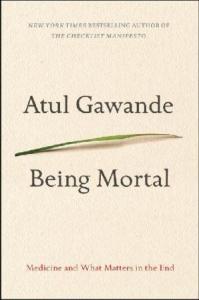The book seems to be everywhere. I haven’t come across a 2014 book list that doesn’t have this one listed. So after a long wait, I could finally put my hands on Being Mortal.
If there is one absolute, unwavering truth in everyone’s life, that one thing that will happen no matter what, it is death. In a week, a month, or decades from now. Dr. Gawande says that this ultimate truth is becoming more difficult to digest for people than it was few decades ago. This expectation he attributes to both advances in medical science and people’s ability to afford good health care.
Dr. Atul Gawande is a surgeon and a public health researcher. He has authored other bestsellers like The Checklist Manifesto: How to get Things Right and Complications: A Surgeon’s Notes on an Imperfect Science.
Warning: Do not read if talk of death, dying, illness, surgeries depresses you.
 Being Mortal: Medicine and What Matters in the End
Being Mortal: Medicine and What Matters in the End
Pages: 304 pages
Publisher: Metropolitan Books; 1 edition (October 7, 2014)
ISBN-10: 0805095152, 978-0805095159
The author begins with his reservations about medical education that teaches students how to deal with the body but fails to sensitize them of people’s aspirations, which change from person to person. People have different phobias and doubts about the outcome of the treatment or the prognosis of the illness. The first few chapters talk about how doctors are prepared to fix medical problems but fail when this medical knowledge needs to be combined with a supporting ear while treating aging patients. He points out that there is no cure to aging and that doctors are often overwhelmed when they can neither fix the multitude of problems, nor have the skill to communicate and explain this to the aging patients.
He investigates various social and economic factors that have lead to the current state of the aging and the patients in their last stages of life. He narrates this with minimum technical mumbo jumbo with stories of different patients and those close to him and his family.

Changing social values, public health care systems, and developments in surgery and other treatments have allowed people to stretch the average lifespan. But all these have its limitations and disadvantages. Senior citizen communities and assisted living only help the young satisfy their own guilt and insecurities, but do not necessarily help the aged members of the family. The author explores the current conditions of such communities and highlights that the problem lies in the mission statement of such institutions. A statement that concentrates on the physical safety and comfort of the inhabitants but completely bypasses the mental well-being.
But it is not only the aged who face this prospect of failing health and dependency. Young, terminally ill patients too face the same situation and are forced to weigh various alternatives and choose the course of action that needs to be taken. It is not always easy to look at things analytically when evaluating the value of your life. Neither is it easy for the family members to do this for the ill. The drive to give all the information to the patient is good, it is definitely not possible to make a decision without all the relevant information. But you can get a right answer only to a right question. The author believes that a doctor’s responsibility must go beyond dishing out the information. The doctors must also listen to the patients’ primary concern and things that they are willing to trade-off, the risks that they are ready to take and then explain the available choices.
So the question remains. When is it time to let go? Would you like to die at your home with your family members or do you want the doctors to stick multiple tubes and cut you to extend life for a few weeks? The choice becomes much easy when you accept your mortality and then see what is most important to you. Everyone dies. The question is how you want to live.
For doctors, the author says that doctors too need to accept patients’ mortality and then focus on helping the dying with this limitation in mind. The goal is not to just to keep the patient alive, but to enable well-being.